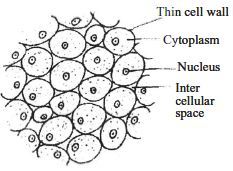9th Grade > Biology
TISSUES MCQs
:
B
A group of similar cells with a common origin specialised to perform a common function are called tissues. E.g., Blood, phloem, muscle, xylem, etc. Various tissues organise to form an organ. Organs, such as heart, lungs, stomach, kidneys, skin, liver, etc are made up of two or more types of tissues organised to serve a particular function. The organs organise to form an organ system.
:
B
The amount of dead tissue is more in plants than animals. Many essential functions in plants are attributed to dead tissues. Dead tissue provides support and mechanical strength to plants, e.g., sclerenchyma. Apart from this, the main conducting tissue in plants, xylem is mostly composed of dead cells.
:
A
There is no demarcation of dividing and non-dividing regions in animals. Hence, cell growth in animals is more uniform. In plants, growth and active cell multiplication is restricted to meristematic regions.
:
B
Plant tissues are broadly classified into meristematic and permanent tissues, based on their ability to divide. Meristematic tissues are group of cells, which have the ability to divide. This tissue consists of small, cuboidal and densely packed cells, which keeps on dividing to form new cells. The tissues, which are derived from the meristematic tissues, are called permanent tissues. They are the tissues, which have lost their ability to divide as they have attained their mature form.
:
D
Sclerenchyma is the tissue which makes the plant hard and stiff. The husk of a coconut is made of sclerenchymatous tissue. The cells of this tissue are dead. They are long and narrow as the walls are thickened due to lignin.
:
B
The covering or protective tissues in the animal body are epithelial tissues. Epithelium covers most organs and cavities such as the skin, the lining of the mouth, the lining of blood vessels, lung alveoli and kidney tubules.
:
A
Parenchyma cells have thin walls. They are live cells. They are usually loosely packed, and large intercellular spaces are found in this tissue. Therefore, the slide consists of parenchyma cells. Sclerenchyma is the tissue which makes the plant, hard and stiff. Aerolar tissue and epithelium are animals tissues.
Sclerenchyma is the tissue which makes the plant, hard and stiff. Aerolar tissue and epithelium are animals tissues.
:
C
Sclerenchyma is a dead simple permanent tissue in plants. The walls of sclerenchyma cells are thick due to the deposition of a complex sugar called lignin. For example, husk of a coconut. Parenchyma tissue on the other hand, is a living tissue. It consists of relatively unspecialised cells with thin cell walls.
:
A, B, and C
Skeletal muscles are made up of long and cylindrical cells. They are multinucleate (having many nuclei) and unbranched. They are also known as striated muscles because they have alternate dark and light bands. They move as per our will, hence they are categorised as voluntary muscles. They are mostly attached to bones. They help in body movements.

















